Simultaneous Monitoring of Outdoor PAHs and Particles in a French Peri-Urban Site during COVID Restrictions and the Winter Saharan Dust Event
Abstract
:1. Introduction
2. Materials and Methods
2.1. Experimental Campaign Locations
2.2. Particulate Matter Sampling Methodology
2.2.1. Three-Stage Cascade Impactor
2.2.2. Particle Analyser
2.3. Extraction and Chemical Analysis of Extracted Organic Phases
2.4. Calibration Curves
3. Results
3.1. Particulate Matter Concentration
3.1.1. Temporal Variation of PM Concentration
3.1.2. Average PM Concentrations in Air
3.2. Concentration of Particulate-Bound PAHs
3.2.1. Total PAH Concentration
3.2.2. Individual PAH Concentrations
4. Discussion
4.1. Particulate Matter Concentration
4.1.1. Temporal Variation of PM Concentration
4.1.2. Average PM Concentrations in Air
4.2. Concentration of Particulate-Bound PAHs
4.2.1. Total PAH Concentration
4.2.2. Individual PAH Concentration
4.2.3. Health Risk Assessment Due to PAH Exposure
5. Conclusions
Supplementary Materials
Author Contributions
Funding
Institutional Review Board Statement
Informed Consent Statement
Data Availability Statement
Acknowledgments
Conflicts of Interest
References
- Leung, D.Y.C. Outdoor-Indoor Air Pollution in Urban Environment: Challenges and Opportunity. Front. Environ. Sci. 2015, 2, 69. [Google Scholar] [CrossRef]
- World Health Organization (Ed.) Air Quality Guidelines: Global Update 2005: Particulate Matter, Ozone, Nitrogen Dioxide, and Sulfur Dioxide; World Health Organization: Copenhagen, Denmark, 2006; ISBN 978-92-890-2192-0. [Google Scholar]
- CEC Directive 2008/50/EC of the European Parliament and of the Council of 21 May 2008 on Ambient Air Quality and Cleaner Air for Europe. Off. J. Eur. Union 2008, L152, 1–44.
- CEC Directive 2004/107/EC of the European Parliament and of the Council of 15 December 2004 Relating to Arsenic, Cadmium, Mercury, Nickel and Polycyclic Aromatic Hydrocarbons in Ambient Air. Off. J. Eur. Union 2004, L23, 316.
- Marco, G.; Bo, X. Air Quality Legislation and Standards in the European Union: Background, Status and Public Participation. Adv. Clim. Chang. Res. 2013, 4, 50–59. [Google Scholar] [CrossRef]
- Viana, M.; Pey, J.; Querol, X.; Alastuey, A.; de Leeuw, F.; Lükewille, A. Natural Sources of Atmospheric Aerosols Influencing Air Quality across Europe. Sci. Total Environ. 2014, 472, 825–833. [Google Scholar] [CrossRef]
- Kim, K.-H.; Kabir, E.; Kabir, S. A Review on the Human Health Impact of Airborne Particulate Matter. Environ. Int. 2015, 74, 136–143. [Google Scholar] [CrossRef] [PubMed]
- Rodríguez, S.; Querol, X.; Alastuey, A.; de la Rosa, J. Atmospheric Particulate Matter and Air Quality in the Mediterranean: A Review. Environ. Chem. Lett. 2007, 5, 1–7. [Google Scholar] [CrossRef]
- Kuklinska, K.; Wolska, L.; Namiesnik, J. Air Quality Policy in the U.S. and the EU—A Review. Atmos. Pollut. Res. 2015, 6, 129–137. [Google Scholar] [CrossRef]
- Dat, N.-D.; Chang, M.B. Review on Characteristics of PAHs in Atmosphere, Anthropogenic Sources and Control Technologies. Sci. Total Environ. 2017, 609, 682–693. [Google Scholar] [CrossRef]
- Mojiri, A.; Zhou, J.L.; Ohashi, A.; Ozaki, N.; Kindaichi, T. Comprehensive Review of Polycyclic Aromatic Hydrocarbons in Water Sources, Their Effects and Treatments. Sci. Total Environ. 2019, 696, 133971. [Google Scholar] [CrossRef]
- Zhang, L.; Yang, L.; Zhou, Q.; Zhang, X.; Xing, W.; Wei, Y.; Hu, M.; Zhao, L.; Toriba, A.; Hayakawa, K.; et al. Size Distribution of Particulate Polycyclic Aromatic Hydrocarbons in Fresh Combustion Smoke and Ambient Air: A Review. J. Environ. Sci. 2020, 88, 370–384. [Google Scholar] [CrossRef] [PubMed]
- Dimashki, M.; Lim, L.H.; Harrison, R.M.; Harrad, S. Temporal Trends, Temperature Dependence, and Relative Reactivity of Atmospheric Polycyclic Aromatic Hydrocarbons. Environ. Sci. Technol. 2001, 35, 2264–2267. [Google Scholar] [CrossRef] [PubMed]
- He, J.; Fan, S.; Meng, Q.; Sun, Y.; Zhang, J.; Zu, F. Polycyclic Aromatic Hydrocarbons (PAHs) Associated with Fine Particulate Matters in Nanjing, China: Distributions, Sources and Meteorological Influences. Atmos. Environ. 2014, 89, 207–215. [Google Scholar] [CrossRef]
- Querol, X.; Pérez, N.; Reche, C.; Ealo, M.; Ripoll, A.; Tur, J.; Pandolfi, M.; Pey, J.; Salvador, P.; Moreno, T.; et al. African Dust and Air Quality over Spain: Is It Only Dust That Matters? Sci. Total Environ. 2019, 686, 737–752. [Google Scholar] [CrossRef]
- Nouvelle Remontée de Sable du Sahara sur la France—Actualités La Chaîne Météo. Available online: https://actualite.lachainemeteo.com/actualite-meteo/2021-03-01/nouvelle-remontee-de-sable-du-sahara-sur-la-france-58539 (accessed on 14 July 2022).
- Épisodes de Pollution|ATMO Grand Est. Available online: http://www.atmo-grandest.eu/episodes-de-pollution (accessed on 14 July 2022).
- L’Alsace en Vigilance Jaune Vent Violent, Des Rafales de 100 km/h Attendues en Plaine. Available online: https://www.francebleu.fr/infos/meteo/l-alsace-toujours-en-vigilance-jaune-vent-violence-1615556378 (accessed on 14 July 2022).
- Liaud, C.; Millet, M.; Le Calvé, S. An Analytical Method Coupling Accelerated Solvent Extraction and HPLC-Fluorescence for the Quantification of Particle-Bound PAHs in Indoor Air Sampled with a 3-Stages Cascade Impactor. Talanta 2015, 131, 386–394. [Google Scholar] [CrossRef]
- Atmo Grand Est Episode de Pollution de l’air Dans le Grand Est, Polluant PM10, 25 Février 2021. Available online: http://www.atmo-grandest.eu/data/statements/20210225/ATMO_GrandEst_Alerte_PM10_C1_20210225.pdf (accessed on 4 July 2022).
- Atmo Grand Est Episode de Pollution de l’air dans le Grand Est, Polluant PM10, 03 Mars 2021. Available online: http://www.atmo-grandest.eu/data/statements/20210303/ATMO_GrandEst_Alerte_PM10_C1_20210303.pdf. (accessed on 4 July 2022).
- Chen, Z.; Chen, D.; Zhao, C.; Kwan, M.; Cai, J.; Zhuang, Y.; Zhao, B.; Wang, X.; Chen, B.; Yang, J.; et al. Influence of Meteorological Conditions on PM2.5 Concentrations across China: A Review of Methodology and Mechanism. Environ. Int. 2020, 139, 105558. [Google Scholar] [CrossRef]
- Atmo Grand Est Note Sur L’Impact Des Particules Sahariennes Sur Les Niveaux Particulaires de Février 2021 (ENJEM-EN-040). Available online: http://www.atmo-grandest.eu/actualite/sable-du-sahara-quel-constat-sur-la-qualite-de-lair (accessed on 14 July 2022).
- Zhang, L.; Cheng, Y.; Zhang, Y.; He, Y.; Gu, Z.; Yu, C. Impact of Air Humidity Fluctuation on the Rise of PM Mass Concentration Based on the High-Resolution Monitoring Data. Aerosol Air Qual. Res. 2017, 17, 543–552. [Google Scholar] [CrossRef]
- Li, J.; Chen, H.; Li, Z.; Wang, P.; Cribb, M.; Fan, X. Low-Level Temperature Inversions and Their Effect on Aerosol Condensation Nuclei Concentrations under Different Large-Scale Synoptic Circulations. Adv. Atmos. Sci. 2015, 32, 898–908. [Google Scholar] [CrossRef]
- Wang, Z.; Calderón, L.; Patton, A.P.; Sorensen Allacci, M.; Senick, J.; Wener, R.; Andrews, C.J.; Mainelis, G. Comparison of Real-Time Instruments and Gravimetric Method When Measuring Particulate Matter in a Residential Building. J. Air Waste Manag. Assoc. 2016, 66, 1109–1120. [Google Scholar] [CrossRef]
- Giorio, C.; Tapparo, A.; Scapellato, M.L.; Carrieri, M.; Apostoli, P.; Bartolucci, G.B. Field Comparison of a Personal Cascade Impactor Sampler, an Optical Particle Counter and CEN-EU Standard Methods for PM10, PM2.5 and PM1 Measurement in Urban Environment. J. Aerosol Sci. 2013, 65, 111–120. [Google Scholar] [CrossRef]
- Wallace, L.A.; Wheeler, A.J.; Kearney, J.; Van Ryswyk, K.; You, H.; Kulka, R.H.; Rasmussen, P.E.; Brook, J.R.; Xu, X. Validation of Continuous Particle Monitors for Personal, Indoor, and Outdoor Exposures. J. Expo. Sci. Environ. Epidemiol. 2011, 21, 49–64. [Google Scholar] [CrossRef] [PubMed]
- Karanasiou, A.; Moreno, N.; Moreno, T.; Viana, M.; de Leeuw, F.; Querol, X. Health Effects from Sahara Dust Episodes in Europe: Literature Review and Research Gaps. Environ. Int. 2012, 47, 107–114. [Google Scholar] [CrossRef] [PubMed]
- Atmo Grand Est Bilan Qualité de l’air Bas-Rhin 2020. Available online: http://www.atmo-grandest.eu/document/2636 (accessed on 24 August 2022).
- Liaud, C.; Dintzer, T.; Tschamber, V.; Trouve, G.; Le Calvé, S. Particle-Bound PAHs Quantification Using a 3-Stages Cascade Impactor in French Indoor Environments. Environ. Pollut. 2014, 195, 64–72. [Google Scholar] [CrossRef] [PubMed]
- Junyapoon Size Distributions of Particulate Matter and Particle-Bound Polycyclic Aromatic Hydrocarbons and Their Risk Assessments during Cable Sheath Burning. Curr. Appl. Sci. Technol. 2019, 19, 140153. [CrossRef]
- Allen, J.O.; Dookeran, N.M.; Smith, K.A.; Sarofim, A.F.; Taghizadeh, K.; Lafleur, A.L. Measurement of Polycyclic Aromatic Hydrocarbons Associated with Size-Segregated Atmospheric Aerosols in Massachusetts. Environ. Sci. Technol. 1996, 30, 1023–1031. [Google Scholar] [CrossRef]
- Abdel-Shafy, H.I.; Mansour, M.S.M. A Review on Polycyclic Aromatic Hydrocarbons: Source, Environmental Impact, Effect on Human Health and Remediation. Egypt. J. Pet. 2016, 25, 107–123. [Google Scholar] [CrossRef]
- Zhu, Y.; Yang, L.; Yuan, Q.; Yan, C.; Dong, C.; Meng, C.; Sui, X.; Yao, L.; Yang, F.; Lu, Y.; et al. Airborne Particulate Polycyclic Aromatic Hydrocarbon (PAH) Pollution in a Background Site in the North China Plain: Concentration, Size Distribution, Toxicity and Sources. Sci. Total Environ. 2014, 466–467, 357–368. [Google Scholar] [CrossRef] [PubMed]
- Liaud, C.; Chouvenc, S.; Le Calvé, S. Simultaneous Monitoring of Particle-Bound PAHs Inside a Low-Energy School Building and Outdoors over Two Weeks in France. Atmosphere 2021, 12, 108. [Google Scholar] [CrossRef]
- Price, P.S.; Jayjock, M.A. Available Data on Naphthalene Exposures: Strengths and Limitations. Regul. Toxicol. Pharmacol. 2008, 51, 15–21. [Google Scholar] [CrossRef] [PubMed]
- Galán-Madruga, D.; Terroba, J.M.; dos Santos, S.G.; Úbeda, R.M.; García-Cambero, J.P. Indoor and Outdoor PM10-Bound PAHs in an Urban Environment. Similarity of Mixtures and Source Attribution. Bull. Environ. Contam. Toxicol. 2020, 105, 951–957. [Google Scholar] [CrossRef]
- Liu, S.; Xia, X.; Yang, L.; Shen, M.; Liu, R. Polycyclic Aromatic Hydrocarbons in Urban Soils of Different Land Uses in Beijing, China: Distribution, Sources and Their Correlation with the City’s Urbanization History. J. Hazard. Mater. 2010, 177, 1085–1092. [Google Scholar] [CrossRef] [PubMed]
- Atmo Grand Est Surveillance Réglementaire Des Hydrocarbures Aromatiques Polycycliques Dans l’air Ambiant Site “Clémenceau”—Valeurs Des 12 Derniers Mois En Date Du 31/12/18. Available online: http://www.atmo-grandest.eu/sites/prod/files/2019-03/Bulletin_trimestriel_HAP_Clemenceau_122018.pdf (accessed on 24 August 2022).
- Nisbet, I.C.T.; LaGoy, P.K. Toxic Equivalency Factors (TEFs) for Polycyclic Aromatic Hydrocarbons (PAHs). Regul. Toxicol. Pharmacol. 1992, 16, 290–300. [Google Scholar] [CrossRef]
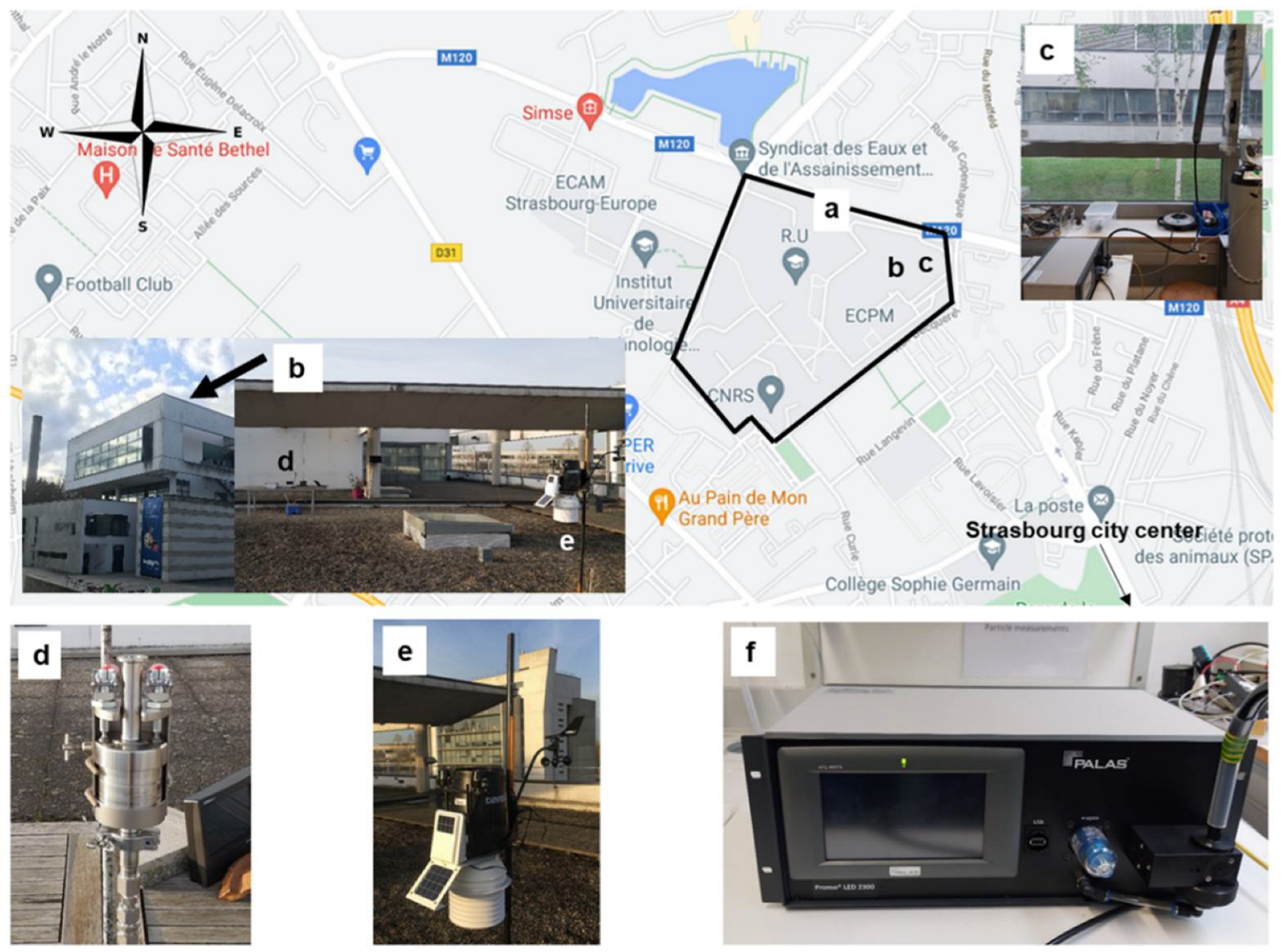
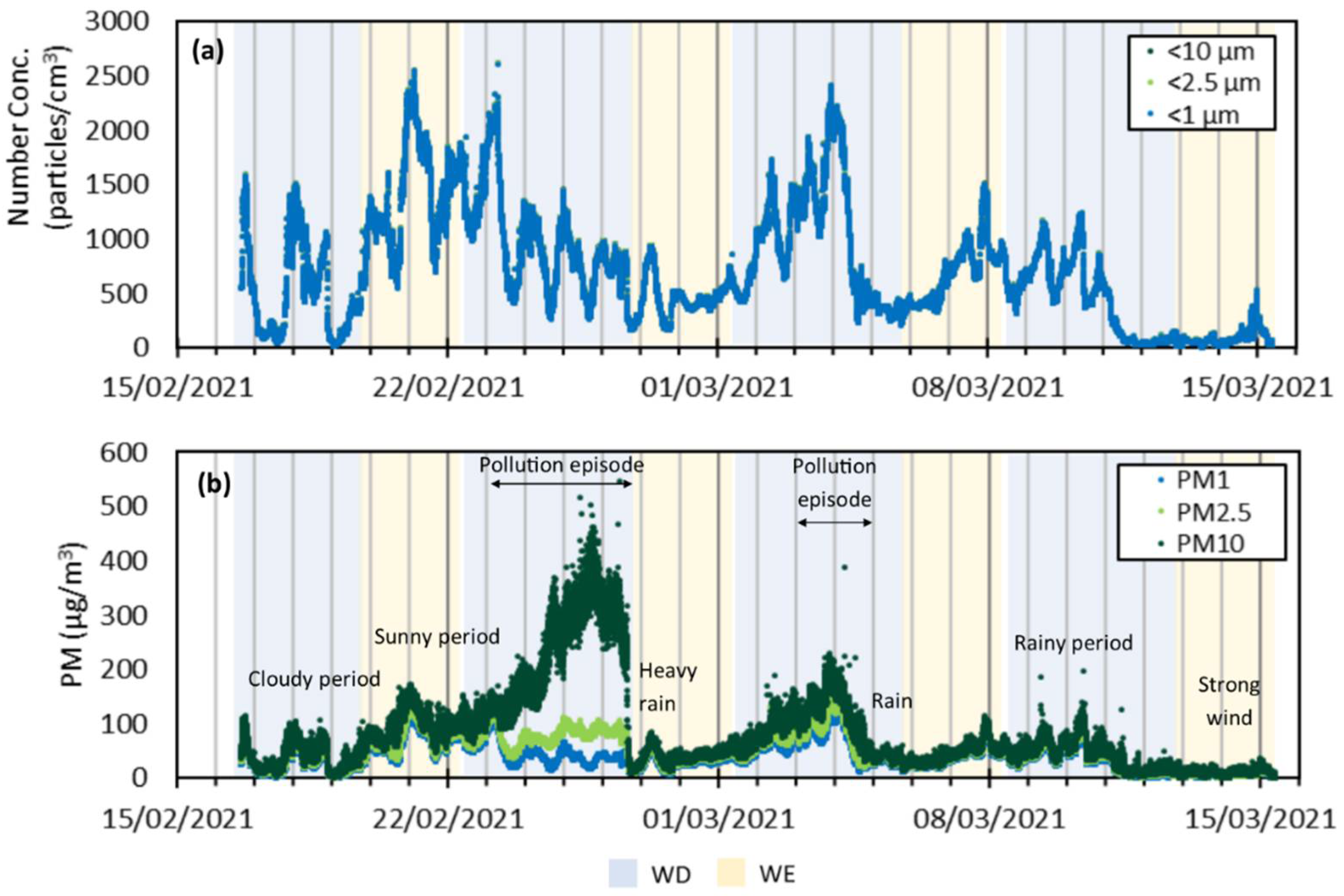
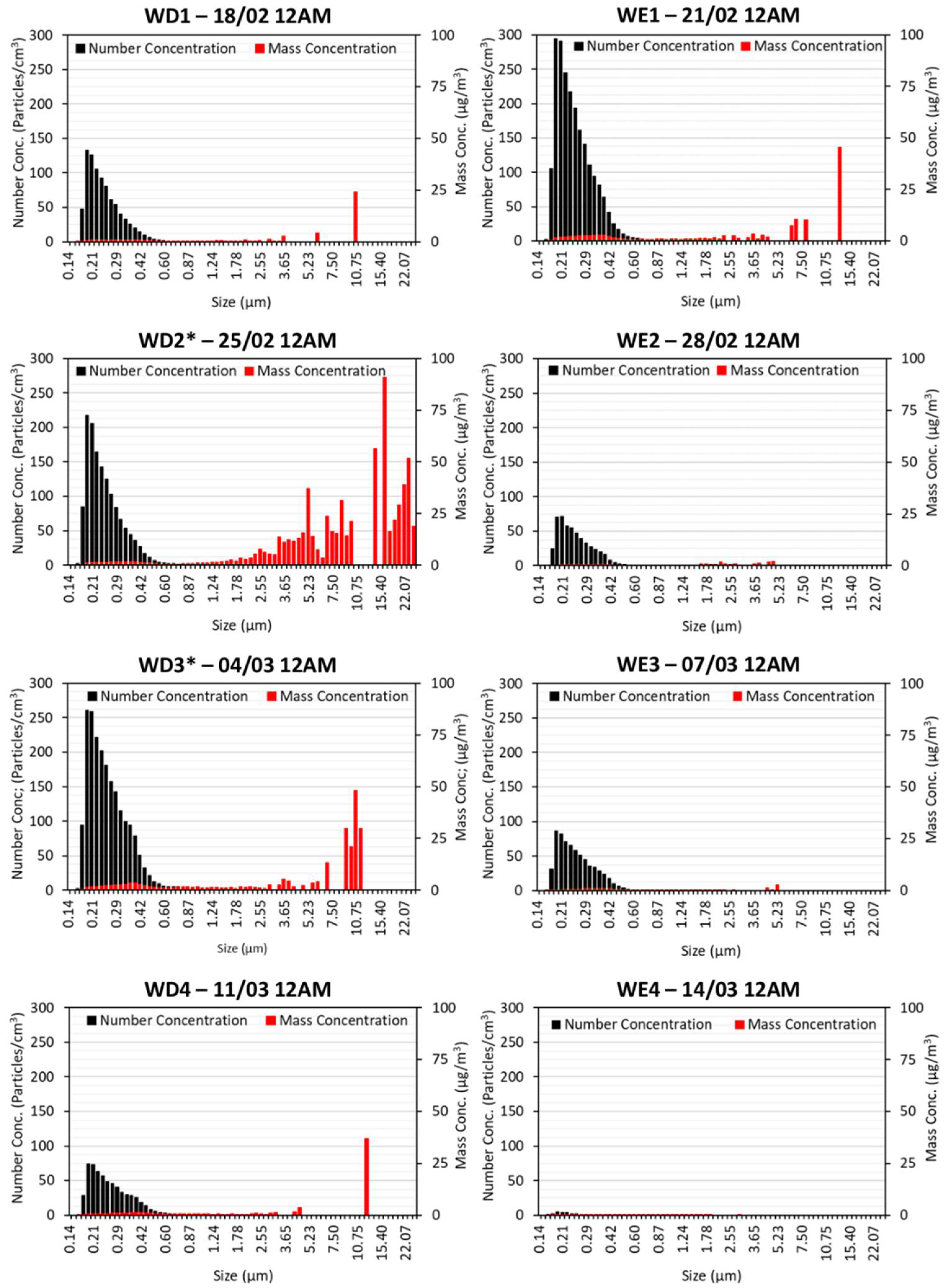
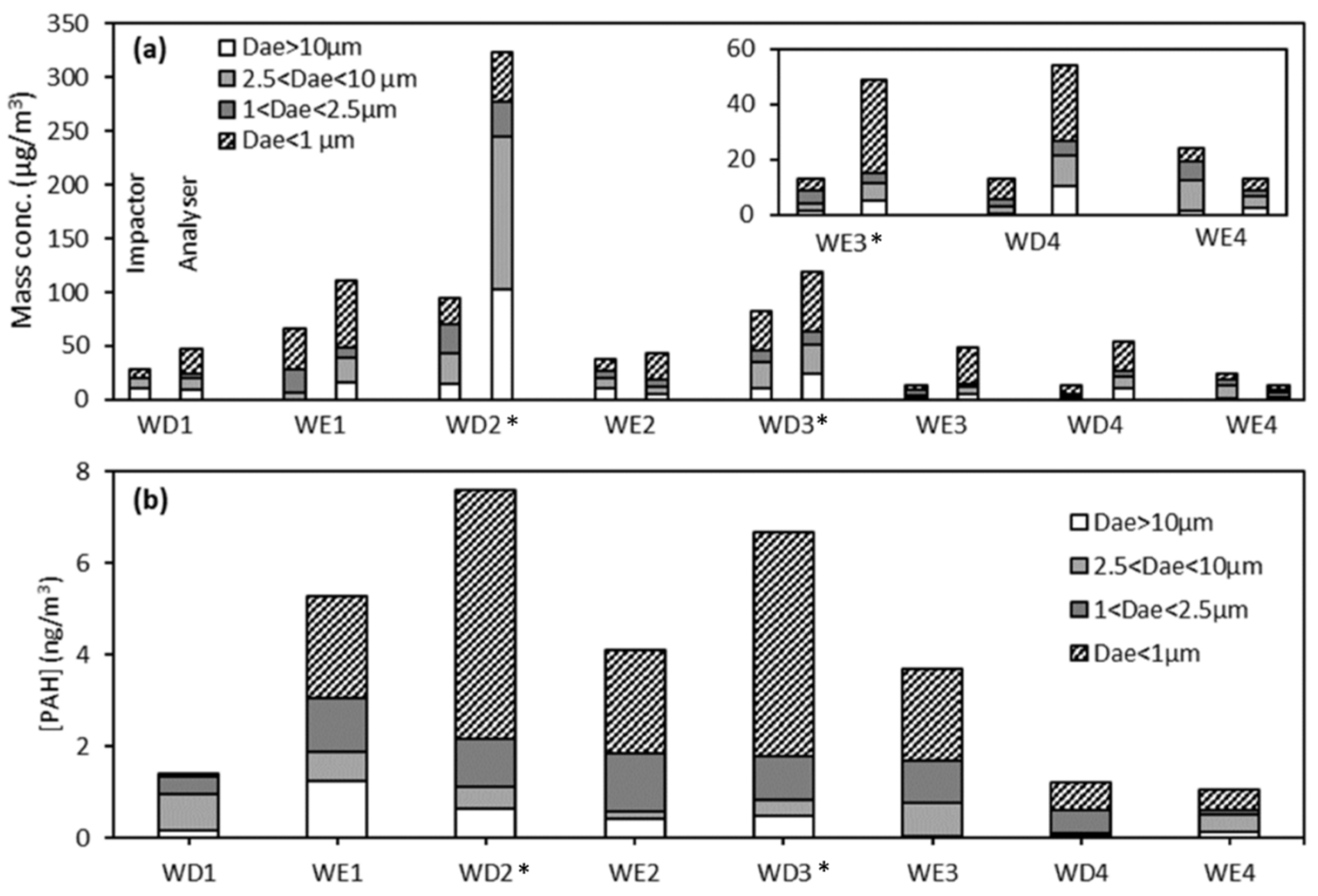
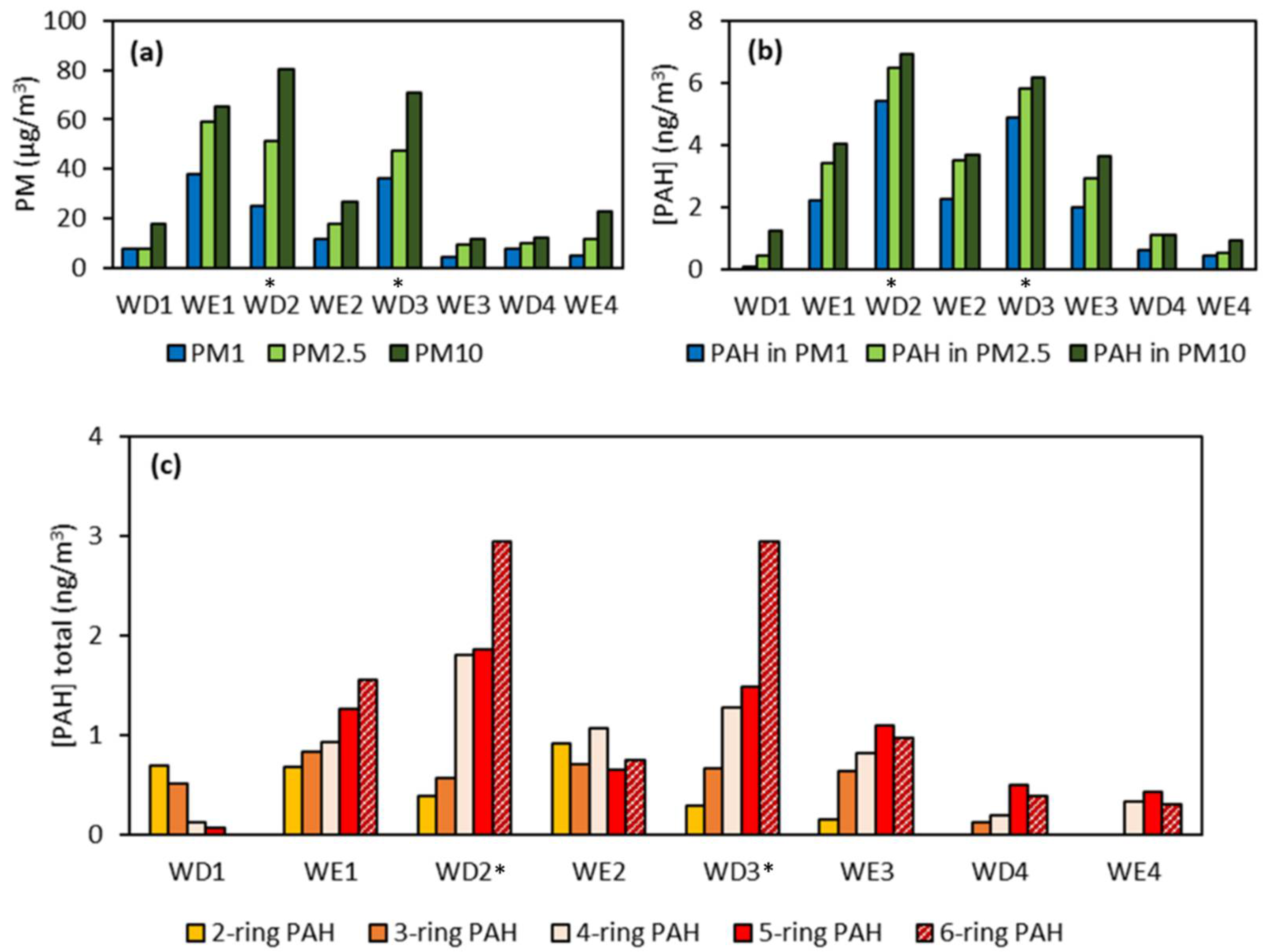
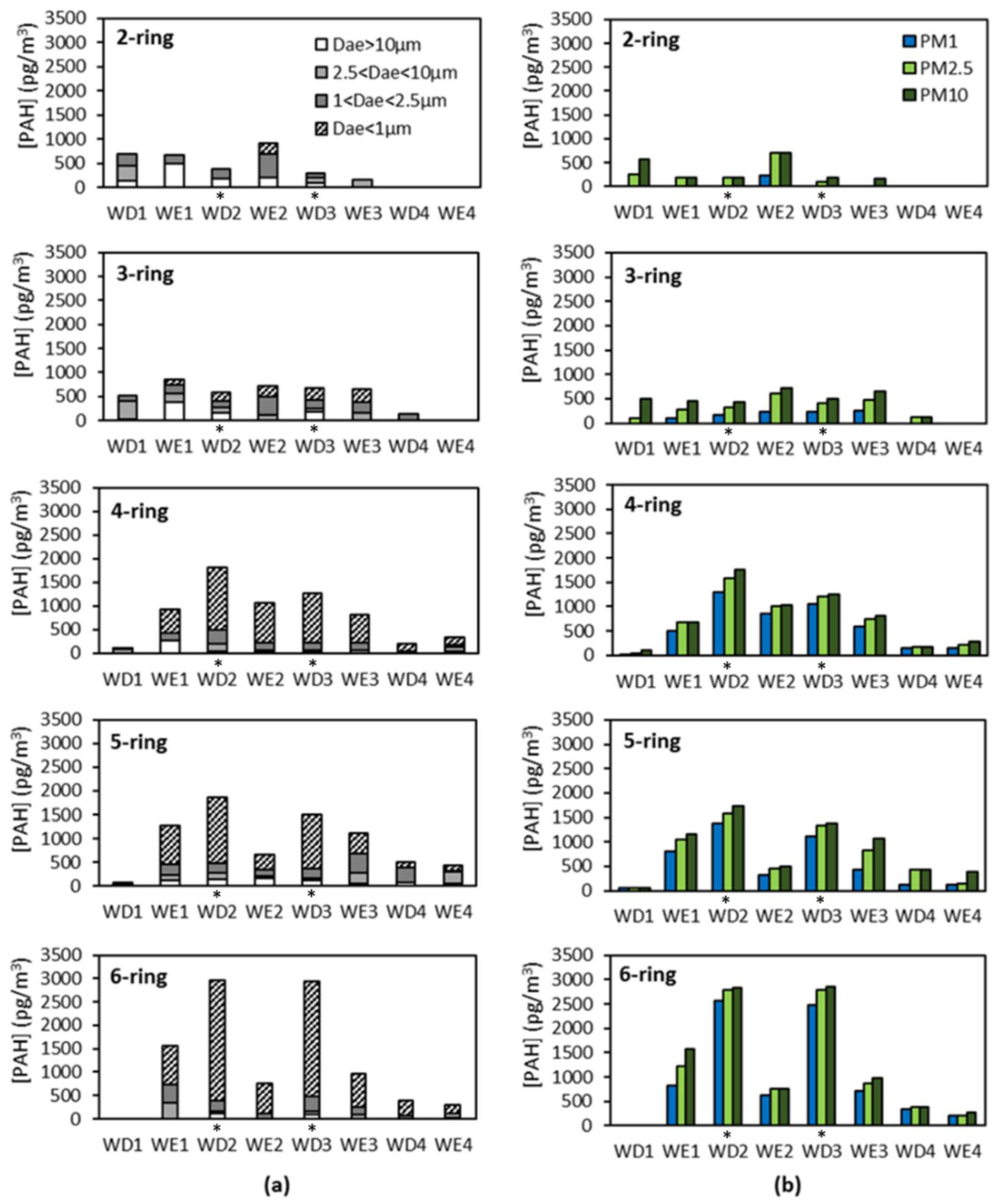

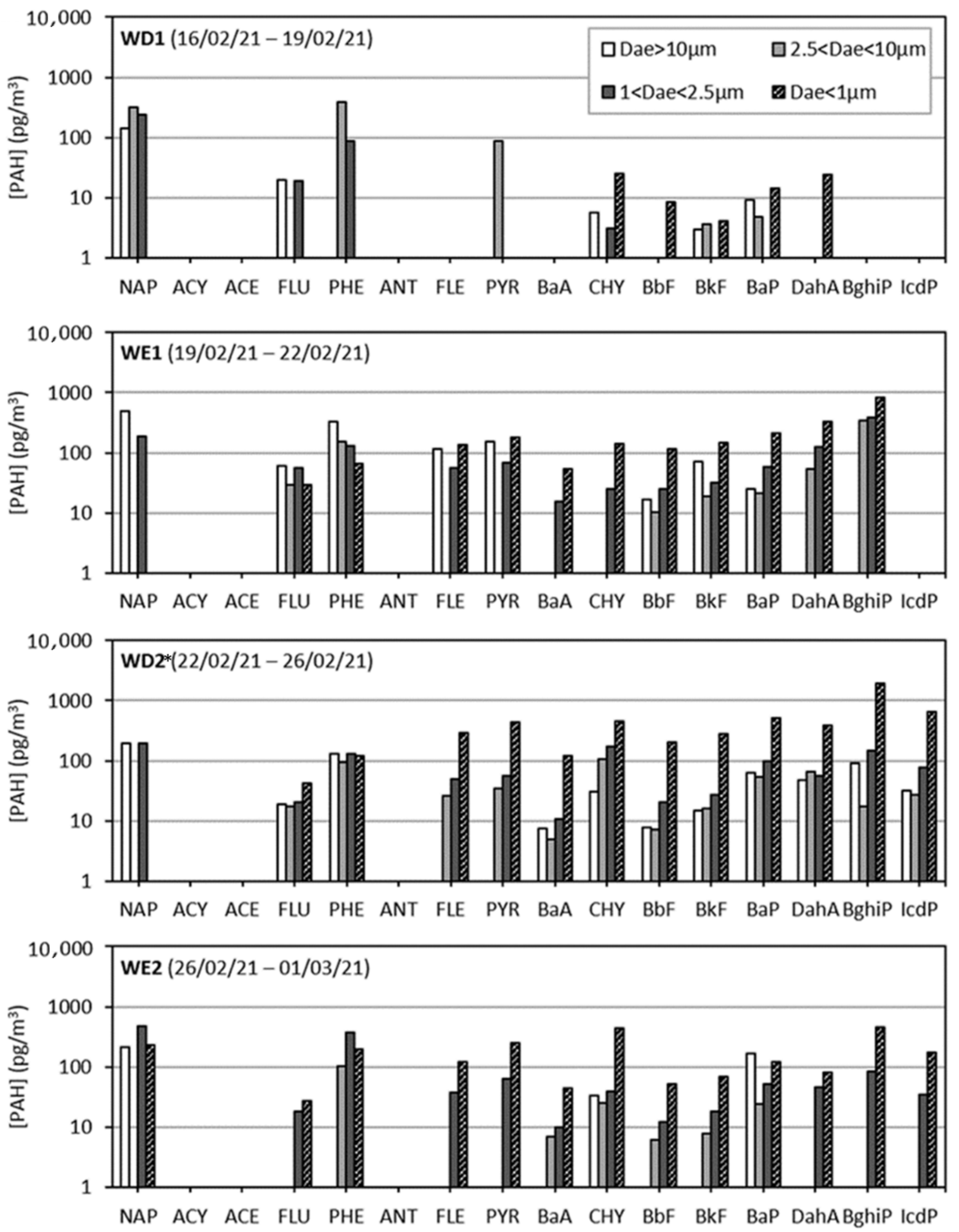
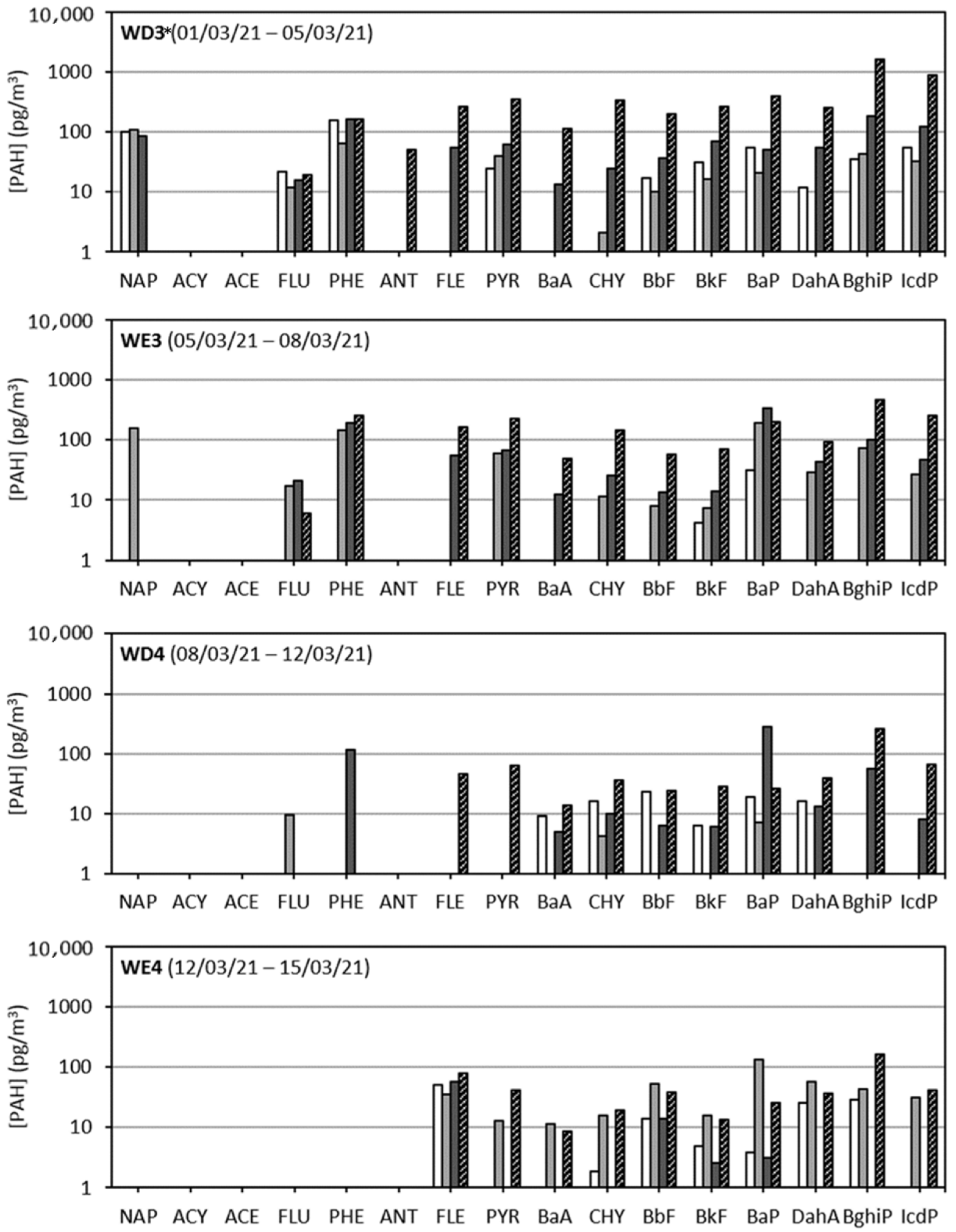
| Period | Start | End | Duration (h) | Flow (m3/h) | Air Volume (m3) | ||
|---|---|---|---|---|---|---|---|
| Date | Hour | Date | Hour | ||||
| WD1 | 16 February 2021 | 15:49 | 19 February 2021 | 16:05 | 72.27 | 1.8 | 130.08 |
| WE1 | 19 February 2021 | 16:42 | 22 February 2021 | 8:57 | 64.25 | 1.8 | 115.65 |
| WD2 | 22 February 2021 | 9:45 | 26 February 2021 | 15:36 | 101.85 | 1.8 | 183.33 |
| WE2 | 26 February 2021 | 16:10 | 1 March 2021 | 8:58 | 64.80 | 1.8 | 116.64 |
| WD3 | 1 March 2021 | 9:37 | 5 March 2021 | 15:38 | 102.02 | 1.8 | 183.63 |
| WE3 | 5 March 2021 | 16:06 | 8 March 2021 | 9:03 | 64.95 | 1.8 | 116.91 |
| WD4 | 8 March 2021 | 9:29 | 12 March 2021 | 15:36 | 102.12 | 1.8 | 183.81 |
| WE4 | 12 March 2021 | 16:12 | 15 March 2021 | 9:12 | 65.00 | 1.8 | 117.00 |
| Period | Three-Stage Cascade Impactor DEKATI | Particle Analyser Promo LED 2300 a | ||||||||||||||
|---|---|---|---|---|---|---|---|---|---|---|---|---|---|---|---|---|
| A b | B b | C b | D b | PM1 | PM2.5 | PM10 | PM Total | A b | B b | C b | D b | PM1 | PM2.5 | PM10 | PM Total | |
| WD1 | 10.6 | 9.8 | 0.0 | 7.9 | 7.9 | 7.9 | 17.7 | 28.3 | 9.1 | 11.1 | 4.7 | 21.8 | 21.8 | 26.5 | 37.6 | 46.7 |
| WE1 | 0.4 | 6.1 | 21.1 | 37.9 | 37.9 | 59.1 | 65.2 | 65.6 | 16.5 | 22.9 | 9.2 | 62.2 | 62.2 | 71.4 | 94.3 | 110.7 |
| WD2 * | 14.6 | 29.2 | 25.9 | 25.2 | 25.2 | 51.1 | 80.2 | 94.9 | 102.6 | 141.7 | 32.7 | 45.7 | 45.7 | 78.5 | 220.2 | 322.8 |
| WE2 | 11.2 | 9.0 | 6.1 | 11.6 | 11.6 | 17.7 | 26.7 | 37.9 | 4.6 | 7.8 | 5.9 | 25.2 | 25.2 | 31.0 | 38.8 | 43.4 |
| WD3 * | 11.3 | 23.5 | 11.1 | 36.2 | 36.2 | 47.4 | 70.9 | 82.2 | 24.1 | 27.0 | 11.9 | 55.4 | 55.4 | 67.3 | 94.3 | 118.4 |
| WE3 | 1.2 | 2.7 | 4.9 | 4.2 | 4.2 | 9.1 | 11.8 | 13.0 | 5.3 | 6.1 | 3.6 | 34.0 | 34.0 | 37.7 | 43.8 | 49.0 |
| WD4 | 0.6 | 2.6 | 2.2 | 7.4 | 7.4 | 9.6 | 12.2 | 12.8 | 10.4 | 10.9 | 5.3 | 27.6 | 27.6 | 32.8 | 43.7 | 54.1 |
| WE4 | 1.2 | 11.5 | 6.6 | 4.7 | 4.7 | 11.4 | 22.9 | 24.1 | 2.3 | 4.3 | 2.2 | 4.2 | 4.2 | 6.4 | 10.6 | 13.0 |
Publisher’s Note: MDPI stays neutral with regard to jurisdictional claims in published maps and institutional affiliations. |
© 2022 by the authors. Licensee MDPI, Basel, Switzerland. This article is an open access article distributed under the terms and conditions of the Creative Commons Attribution (CC BY) license (https://creativecommons.org/licenses/by/4.0/).
Share and Cite
Nursanto, F.R.; Vaz-Ramos, J.; Delhomme, O.; Bégin-Colin, S.; Le Calvé, S. Simultaneous Monitoring of Outdoor PAHs and Particles in a French Peri-Urban Site during COVID Restrictions and the Winter Saharan Dust Event. Atmosphere 2022, 13, 1435. https://doi.org/10.3390/atmos13091435
Nursanto FR, Vaz-Ramos J, Delhomme O, Bégin-Colin S, Le Calvé S. Simultaneous Monitoring of Outdoor PAHs and Particles in a French Peri-Urban Site during COVID Restrictions and the Winter Saharan Dust Event. Atmosphere. 2022; 13(9):1435. https://doi.org/10.3390/atmos13091435
Chicago/Turabian StyleNursanto, Farhan Ramadzan, Joana Vaz-Ramos, Olivier Delhomme, Sylvie Bégin-Colin, and Stéphane Le Calvé. 2022. "Simultaneous Monitoring of Outdoor PAHs and Particles in a French Peri-Urban Site during COVID Restrictions and the Winter Saharan Dust Event" Atmosphere 13, no. 9: 1435. https://doi.org/10.3390/atmos13091435
APA StyleNursanto, F. R., Vaz-Ramos, J., Delhomme, O., Bégin-Colin, S., & Le Calvé, S. (2022). Simultaneous Monitoring of Outdoor PAHs and Particles in a French Peri-Urban Site during COVID Restrictions and the Winter Saharan Dust Event. Atmosphere, 13(9), 1435. https://doi.org/10.3390/atmos13091435








